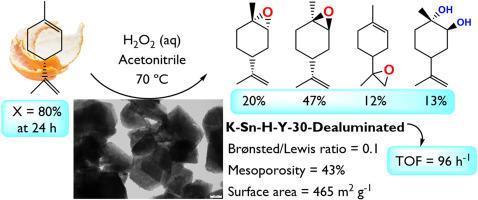当前位置:
X-MOL 学术
›
Micropor. Mesopor. Mater.
›
论文详情
Our official English website, www.x-mol.net, welcomes your feedback! (Note: you will need to create a separate account there.)
Zeolite Y-based catalysts for efficient epoxidation of R-(+)-Limonene: Insights into the structure-activity relationship
Microporous and Mesoporous Materials ( IF 5.2 ) Pub Date : 2024-03-22 , DOI: 10.1016/j.micromeso.2024.113098 Luis A. Gallego-Villada , Päivi Mäki-Arvela , Narendra Kumar , Edwin A. Alarcón , Zuzana Vajglová , Teija Tirri , Ilari Angervo , Robert Lassfolk , Mika Lastusaari , Dmitry Yu Murzin
Microporous and Mesoporous Materials ( IF 5.2 ) Pub Date : 2024-03-22 , DOI: 10.1016/j.micromeso.2024.113098 Luis A. Gallego-Villada , Päivi Mäki-Arvela , Narendra Kumar , Edwin A. Alarcón , Zuzana Vajglová , Teija Tirri , Ilari Angervo , Robert Lassfolk , Mika Lastusaari , Dmitry Yu Murzin

|
Parent, hierarchical, and metal-modified hierarchical zeolite Y were investigated as heterogeneous catalysts in the R-(+)-limonene epoxidation, a catalytic route for synthesizing precursors of bio-polycarbonates, an alternative to isocyanate polyurethanes. The fresh catalysts underwent detailed characterization using XRD, N physisorption, TEM, SEM-EDX, pyridine-FTIR, NH-TPD, CO-TPD, UV–Vis-DRS, and solid-state NMR. Spent materials were investigated by TPO-MS and TGA, confirming low coke formation on the catalytic surface. The most active material was K–Sn-modified dealuminated zeolite Y, reflected in a high turnover frequency (TOF) of 96 h. This material exhibited the lowest Brønsted to Lewis acidity ratio (0.1), the highest mesoporosity fraction (43%), and the lowest total surface area (465 m g). Aprotic polar solvents with high polarity and medium donor capacity appeared suitable for limonene epoxidation. Limonene conversion of ca. 97% was reached at 70 °C, HO: limonene molar ratio = 7, and acetonitrile as a solvent, while selectivity to total monoepoxides exhibited values up to 96% under different reaction conditions. Hydration of internal epoxides to limonene diol was favored at high temperatures and high HO/limonene molar ratios. The efficiency of HO reached maximum values of about 85% at low HO amounts, while no significant influence was observed for temperature, catalyst amount, and the initial concentration of limonene. A plausible reaction mechanism was proposed for the R-(+)-limonene epoxidation with HO based on the experimental findings.
中文翻译:

用于 R-(+)-柠檬烯高效环氧化的 Y 型沸石催化剂:深入了解结构-活性关系
研究了母体、分级和金属改性的分级沸石 Y 作为 R-(+)-柠檬烯环氧化中的非均相催化剂,这是合成生物聚碳酸酯前体(异氰酸酯聚氨酯的替代品)的催化途径。使用 XRD、N 物理吸附、TEM、SEM-EDX、吡啶-FTIR、NH-TPD、CO-TPD、UV-Vis-DRS 和固态 NMR 对新鲜催化剂进行了详细表征。通过 TPO-MS 和 TGA 对用过的材料进行了研究,证实催化表面上的焦炭形成量较低。最活跃的材料是 K-Sn 改性脱铝沸石 Y,其周转频率 (TOF) 高达 96 小时。该材料表现出最低的布朗斯台德酸度与路易斯酸度比(0.1)、最高的中孔率(43%)和最低的总表面积(465 m g)。具有高极性和中等给体能力的非质子极性溶剂似乎适合柠檬烯环氧化。柠檬烯转化率约在 70 °C、H2O: 柠檬烯摩尔比 = 7、乙腈作为溶剂时达到 97%,而在不同反应条件下对总单环氧化物的选择性高达 96%。在高温和高 H2O/柠檬烯摩尔比下有利于内环氧化物水合成柠檬烯二醇。在低 H2O 量下,H2O 的效率达到约 85% 的最大值,而温度、催化剂用量和柠檬烯的初始浓度没有观察到显着影响。根据实验结果,提出了 R-(+)-柠檬烯与 H2O 环氧化的合理反应机理。
更新日期:2024-03-22
中文翻译:

用于 R-(+)-柠檬烯高效环氧化的 Y 型沸石催化剂:深入了解结构-活性关系
研究了母体、分级和金属改性的分级沸石 Y 作为 R-(+)-柠檬烯环氧化中的非均相催化剂,这是合成生物聚碳酸酯前体(异氰酸酯聚氨酯的替代品)的催化途径。使用 XRD、N 物理吸附、TEM、SEM-EDX、吡啶-FTIR、NH-TPD、CO-TPD、UV-Vis-DRS 和固态 NMR 对新鲜催化剂进行了详细表征。通过 TPO-MS 和 TGA 对用过的材料进行了研究,证实催化表面上的焦炭形成量较低。最活跃的材料是 K-Sn 改性脱铝沸石 Y,其周转频率 (TOF) 高达 96 小时。该材料表现出最低的布朗斯台德酸度与路易斯酸度比(0.1)、最高的中孔率(43%)和最低的总表面积(465 m g)。具有高极性和中等给体能力的非质子极性溶剂似乎适合柠檬烯环氧化。柠檬烯转化率约在 70 °C、H2O: 柠檬烯摩尔比 = 7、乙腈作为溶剂时达到 97%,而在不同反应条件下对总单环氧化物的选择性高达 96%。在高温和高 H2O/柠檬烯摩尔比下有利于内环氧化物水合成柠檬烯二醇。在低 H2O 量下,H2O 的效率达到约 85% 的最大值,而温度、催化剂用量和柠檬烯的初始浓度没有观察到显着影响。根据实验结果,提出了 R-(+)-柠檬烯与 H2O 环氧化的合理反应机理。






























 京公网安备 11010802027423号
京公网安备 11010802027423号